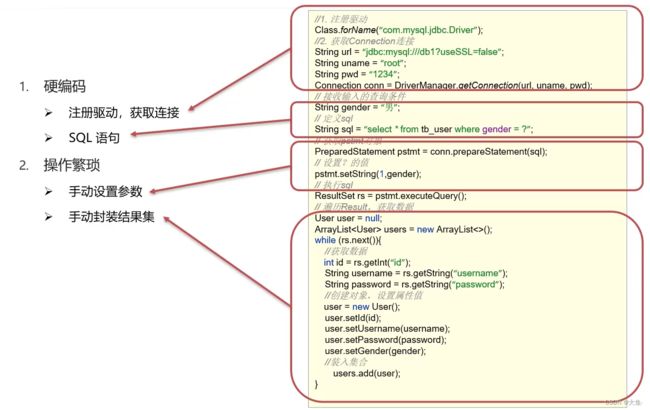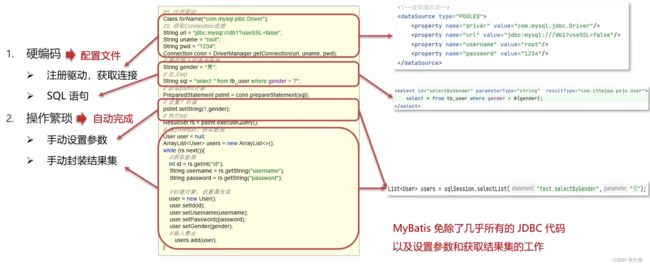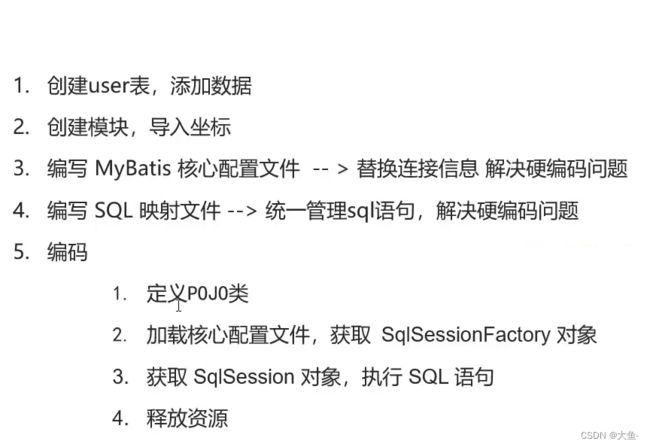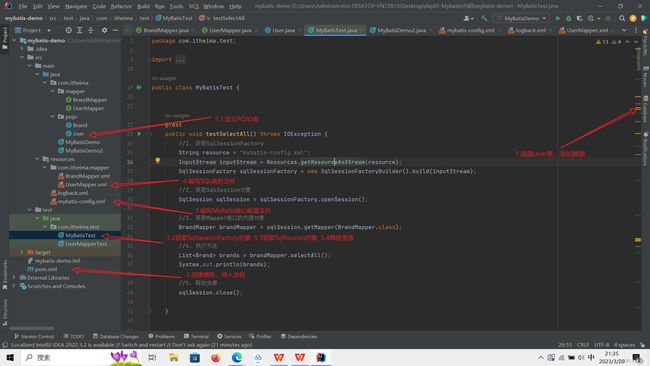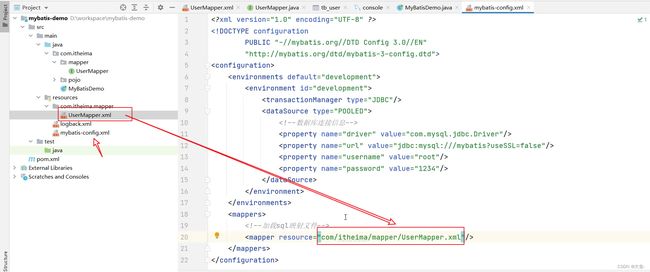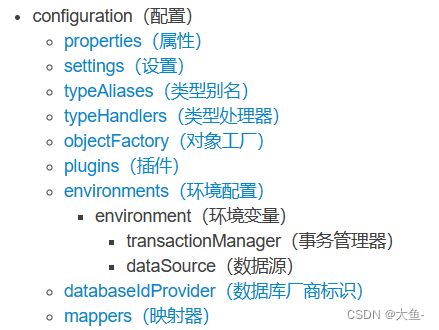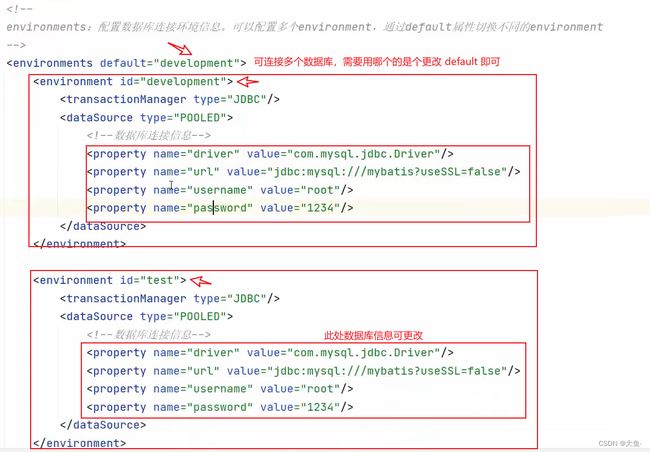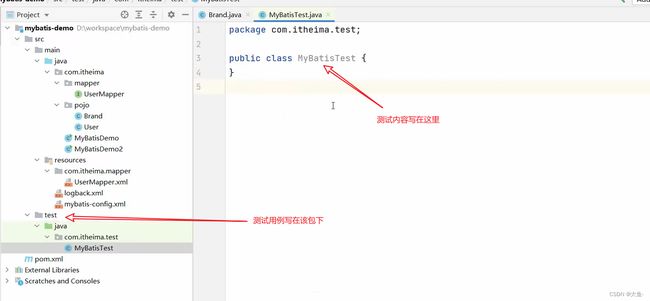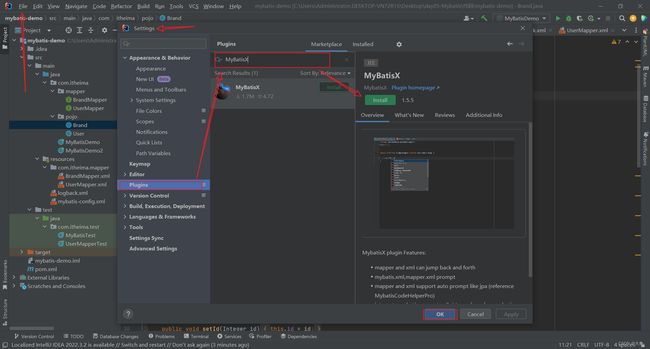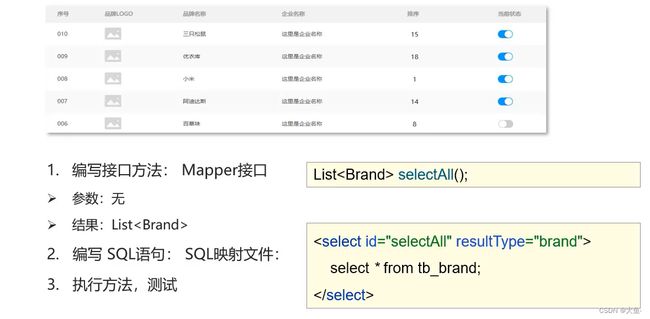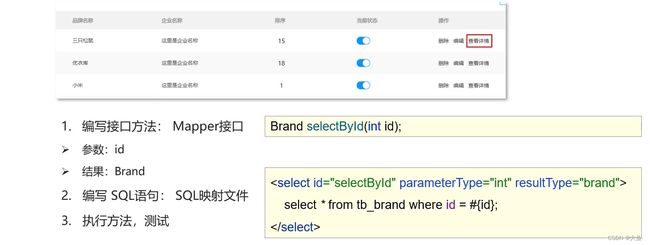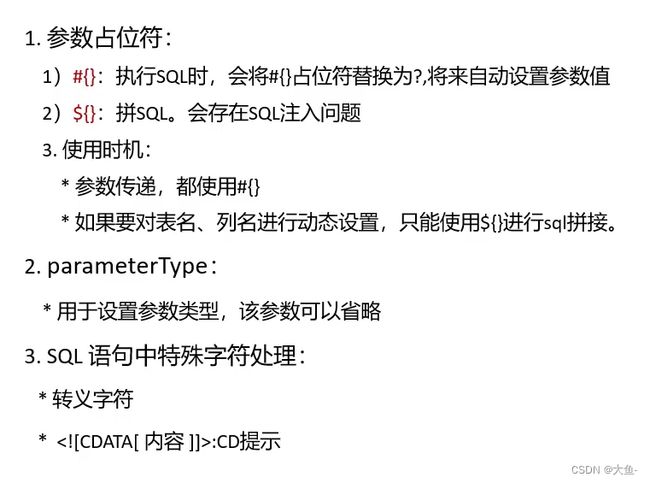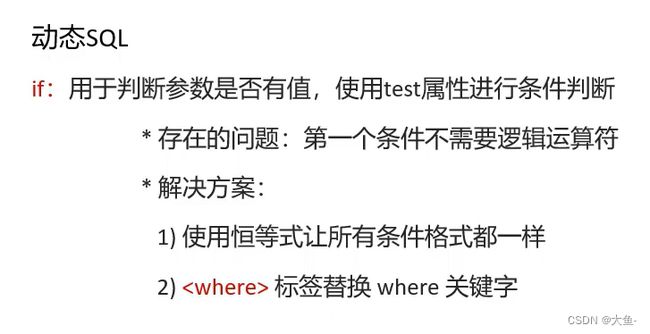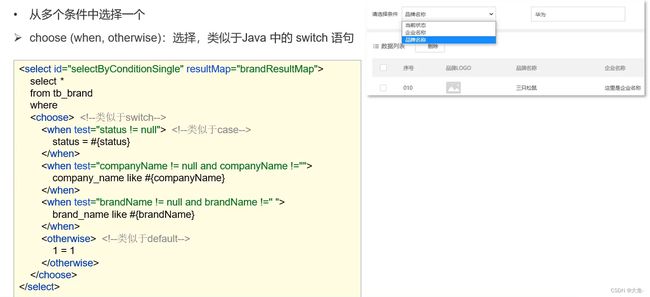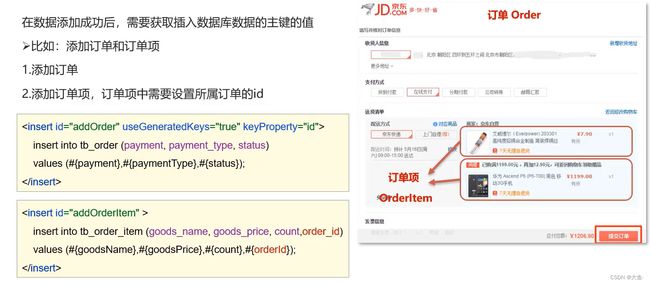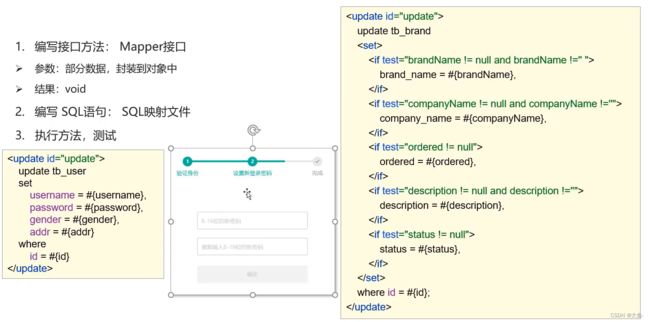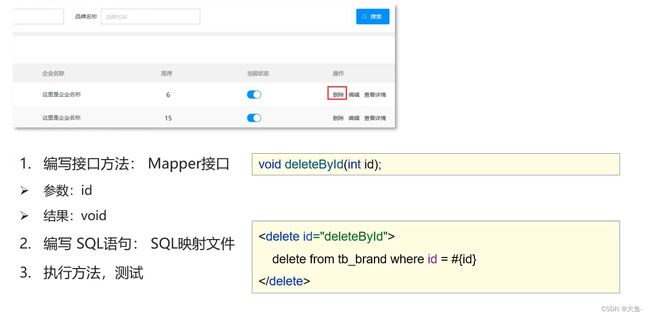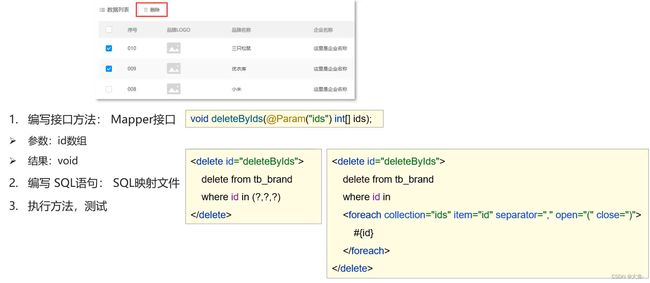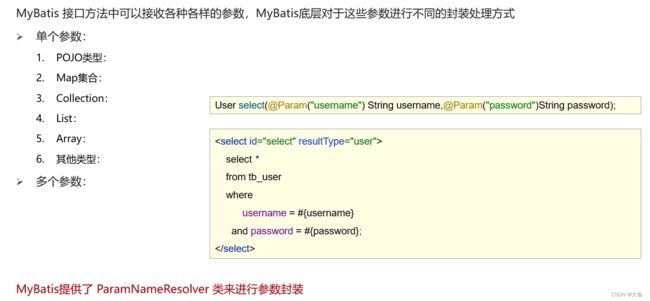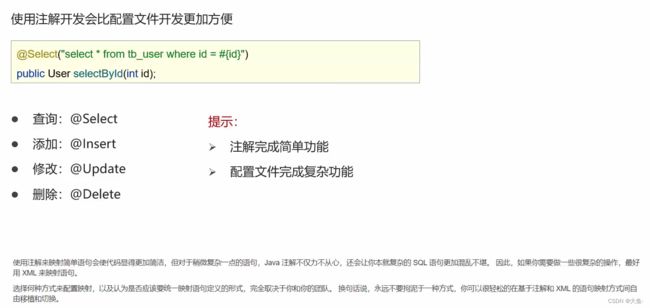【黑马程序员】MyBatis 快速入门
文章目录
- 前言
- 一、MyBatis 介绍
-
- 1.什么是MyBatis
- 2.持久层
- 3.框架
- 4.JDBC 弊端
- 5.MyBatis 简化
- 二、MyBatis 快速入门
-
- 1.查询user表中所有数据
- 2.解决 SQL 映射文件的警告提示
- 三、Mapper 代理开发
-
- 1.目的
- 2.使用 Mapper 代理方式完成入门案例
- 四、MyBatis 核心配置文件
-
- 1.类型别名(typeAliasess)
- 2.数据库配置连接环境信息
- 五、配置文件完成增删改查
-
- 1.准备环境
-
- 1)数据库表 tb_brand
- 2)实体类 Brand
- 3)测试用例
- 4)安装MyBatiisX 插件
- 2.查询
-
- 1)查询所有数据
-
- 属性名与列名不一致
- 2)查看详情
-
- 使用细节
- 3)条件查询
-
- 1.多条件查询
- 2.多条件-动态条件查询
- 3.单条件-动态条件查询
- 3.添加
-
- 主键返回
- 4.修改
-
- 1)修改全部字段
- 2)修改动态字段
- 5.删除
-
- 1)删除一个
- 2)批量删除
- 六、参数传递
-
- 1.单个参数
- 2.多个参数
- 七、注解完成增删改查
- 总结
前言
跟着B站的黑马程序员学习 MyBatis 快速入门
课程传送门:黑马程序员——MyBatis 快速入门
Mybatis代码链接:https://pan.baidu.com/s/1K5BqlQwLPpum3NuuY89ccQ?pwd=6nrd
提取码:6nrd
一、MyBatis 介绍
1.什么是MyBatis
- MyBatis 是一款优秀的持久层框架,用于简化 JDBC 开发
- MyBatis 本是 Apache 的一个开源项目 iBatis,2010 年这个项目由 apache software foundation 迁移到了 google code,并且改名为 MyBatis。2013 年 11 月迁移到 Github
- 官网:点击前往
2.持久层
- 负责将数据到保存到数据库的那一层代码
- JavaEE三层架构:表现层、业务层、持久层
3.框架
- 框架就是一个半成品软件,是一套可重用的、通用的、软件基础代码模型
- 在框架的基础之上构建软件编写更加高效、规范、通用、可扩展
4.JDBC 弊端
5.MyBatis 简化
二、MyBatis 快速入门
1.查询user表中所有数据
create database mybatis;
use mybatis;
drop table if exists tb_user;
create table tb_user(
id int primary key auto_increment,
username varchar(20),
password varchar(20),
gender char(1),
addr varchar(30)
);
INSERT INTO tb_user VALUES (1, 'zhangsan', '123', '男', '北京');
INSERT INTO tb_user VALUES (2, '李四', '234', '女', '天津');
INSERT INTO tb_user VALUES (3, '王五', '11', '男', '西安');
2)创建模块,导入坐标
<project xmlns="http://maven.apache.org/POM/4.0.0"
xmlns:xsi="http://www.w3.org/2001/XMLSchema-instance"
xsi:schemaLocation="http://maven.apache.org/POM/4.0.0 http://maven.apache.org/xsd/maven-4.0.0.xsd">
<modelVersion>4.0.0modelVersion>
<groupId>org.examplegroupId>
<artifactId>mybatis-demoartifactId>
<version>1.0-SNAPSHOTversion>
<properties>
<maven.compiler.source>8maven.compiler.source>
<maven.compiler.target>8maven.compiler.target>
properties>
<dependencies>
<dependency>
<groupId>org.mybatisgroupId>
<artifactId>mybatisartifactId>
<version>3.5.5version>
dependency>
<dependency>
<groupId>mysqlgroupId>
<artifactId>mysql-connector-javaartifactId>
<version>5.1.46version>
dependency>
<dependency>
<groupId>junitgroupId>
<artifactId>junitartifactId>
<version>4.13version>
<scope>testscope>
dependency>
<dependency>
<groupId>org.slf4jgroupId>
<artifactId>slf4j-apiartifactId>
<version>1.7.20version>
dependency>
<dependency>
<groupId>ch.qos.logbackgroupId>
<artifactId>logback-classicartifactId>
<version>1.2.3version>
dependency>
<dependency>
<groupId>ch.qos.logbackgroupId>
<artifactId>logback-coreartifactId>
<version>1.2.3version>
dependency>
dependencies>
project>
3)编写 MyBatis 核心配置文件,替换连接信息,解决硬编码问题
DOCTYPE configuration
PUBLIC "-//mybatis.org//DTD Config 3.0//EN"
"http://mybatis.org/dtd/mybatis-3-config.dtd">
<configuration>
<typeAliases>
<package name="com.itheima.pojo"/>
typeAliases>
<environments default="development">
<environment id="development">
<transactionManager type="JDBC"/>
<dataSource type="POOLED">
<property name="driver" value="com.mysql.jdbc.Driver"/>
<property name="url" value="jdbc:mysql:///mybatis?useSSL=false"/>
<property name="username" value="root"/>
<property name="password" value="123456"/>
dataSource>
environment>
<environment id="test">
<transactionManager type="JDBC"/>
<dataSource type="POOLED">
<property name="driver" value="com.mysql.jdbc.Driver"/>
<property name="url" value="jdbc:mysql:///mybatis?useSSL=false"/>
<property name="username" value="root"/>
<property name="password" value="1234"/>
dataSource>
environment>
environments>
<mappers>
<package name="com.itheima.mapper"/>
mappers>
configuration>
4)编写 SQL 映射文件,统一管理 sql 语句,解决编码问题
DOCTYPE mapper
PUBLIC "-//mybatis.org//DTD Mapper 3.0//EN"
"http://mybatis.org/dtd/mybatis-3-mapper.dtd">
<mapper namespace="com.itheima.mapper.UserMapper">
<select id="selectAll" resultType="user">
select *
from tb_user;
select>
<select id="select" resultType="user">
select *
from tb_user
where
username = #{arg0}
and password = #{param2}
select>
mapper>
5)编码
5-1. 定义 POJO 类
package com.itheima.pojo;
// alt + 鼠标左键 整列编辑
public class User {
private Integer id;
private String username;
private String password;
private String gender;
private String addr;
public Integer getId() {
return id;
}
public void setId(Integer id) {
this.id = id;
}
public String getUsername() {
return username;
}
public void setUsername(String username) {
this.username = username;
}
public String getPassword() {
return password;
}
public void setPassword(String password) {
this.password = password;
}
public String getGender() {
return gender;
}
public void setGender(String gender) {
this.gender = gender;
}
public String getAddr() {
return addr;
}
public void setAddr(String addr) {
this.addr = addr;
}
@Override
public String toString() {
return "User{" +
"id=" + id +
", username='" + username + '\'' +
", password='" + password + '\'' +
", gender='" + gender + '\'' +
", addr='" + addr + '\'' +
'}';
}
}
5-2. 加载核心配置文件,获取 SqlSessionFactory 对象
//1. 获取SqlSessionFactory
String resource = "mybatis-config.xml";
InputStream inputStream = Resources.getResourceAsStream(resource);
SqlSessionFactory sqlSessionFactory = new SqlSessionFactoryBuilder().build(inputStream);
5-3. 获取 SqlSession 对象,执行 SQL 语句
//2. 获取SqlSession对象
SqlSession sqlSession = sqlSessionFactory.openSession();
//3. 获取Mapper接口的代理对象
BrandMapper brandMapper = sqlSession.getMapper(BrandMapper.class);
//4. 执行方法
List<Brand> brands = brandMapper.selectAll();
System.out.println(brands);
5-4. 释放资源
//5. 释放资源
sqlSession.close();
2.解决 SQL 映射文件的警告提示
- 产生原因:Idea 和数据库没有建立连接,不识别表信息
- 解决方式:在 Idea 中配置 MySQL 数据库连接
三、Mapper 代理开发
1.目的
- 解决原生方式中的硬编码
- 简化后期执行 SQL
2.使用 Mapper 代理方式完成入门案例

1.定义与 SQL 映射文件同名的 Mapper 接口,并且将 Mapper 接口和 SQL 映射文件放置在同一目录下
——注意:Mapper文件的包容易出错,建包时可写成 " com/itheima/mapper "
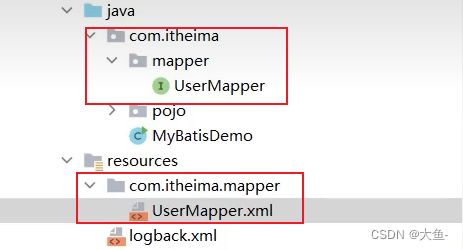
2.设置 SQL 映射文件的 namespace 属性为 Mapper 接口全限定名
3.在 Mapper 接口中定义方法,方法名就是 SQL 映射文件中sql语句的 id,并保持参数类型和返回值类型一致
- 通过 SqlSession 的 getMapper 方式获取 Mapper 接口的代理对象
- 调用对应方法完成 sql 的执行
四、MyBatis 核心配置文件
- 官网:点击前往
注意:配置各个标签,需要遵循前后顺序
1.类型别名(typeAliasess)
2.数据库配置连接环境信息
五、配置文件完成增删改查
1.准备环境
1)数据库表 tb_brand
-- 删除tb_brand表
drop table if exists tb_brand;
-- 创建tb_brand表
create table tb_brand
(
-- id 主键
id int primary key auto_increment,
-- 品牌名称
brand_name varchar(20),
-- 企业名称
company_name varchar(20),
-- 排序字段
ordered int,
-- 描述信息
description varchar(100),
-- 状态:0:禁用 1:启用
status int
);
-- 添加数据
insert into tb_brand (brand_name, company_name, ordered, description, status)
values ('三只松鼠', '三只松鼠股份有限公司', 5, '好吃不上火', 0),
('华为', '华为技术有限公司', 100, '华为致力于把数字世界带入每个人、每个家庭、每个组织,构建万物互联的智能世界', 1),
('小米', '小米科技有限公司', 50, 'are you ok', 1);
SELECT * FROM tb_brand;
2)实体类 Brand
package com.itheima.pojo;
/**
* 品牌
*
* alt + 鼠标左键:整列编辑
*
* 在实体类中,基本数据类型建议使用其对应的包装类型
*/
public class Brand {
// id 主键
private Integer id;
// 品牌名称
private String brandName;
// 企业名称
private String companyName;
// 排序字段
private Integer ordered;
// 描述信息
private String description;
// 状态:0:禁用 1:启用
private Integer status;
public Integer getId() {
return id;
}
public void setId(Integer id) {
this.id = id;
}
public String getBrandName() {
return brandName;
}
public void setBrandName(String brandName) {
this.brandName = brandName;
}
public String getCompanyName() {
return companyName;
}
public void setCompanyName(String companyName) {
this.companyName = companyName;
}
public Integer getOrdered() {
return ordered;
}
public void setOrdered(Integer ordered) {
this.ordered = ordered;
}
public String getDescription() {
return description;
}
public void setDescription(String description) {
this.description = description;
}
public Integer getStatus() {
return status;
}
public void setStatus(Integer status) {
this.status = status;
}
@Override
public String toString() {
return "Brand{" +
"id=" + id +
", brandName='" + brandName + '\'' +
", companyName='" + companyName + '\'' +
", ordered=" + ordered +
", description='" + description + '\'' +
", status=" + status +
'}';
}
}
3)测试用例
4)安装MyBatiisX 插件
2.查询
1)查询所有数据
属性名与列名不一致
1)起别名:在 SQL 语句中,对不一样的类名起别名,别名与实体类属性名一样。可以定义 < sql> 片段,提升复用性。
<sql id="brand_column">
id, brand_name as brandName, company_name as companyName, ordered, description, status
sql>
<select id="selectAll" resultType="brand">
select
<include refid="brand_column" />
from tb_brand;
select>
2)resultMap:定义了 < resultMap> 完成不一致的属性名和列名的映射。
<resultMap id="brandResultMap" type="brand">
<result column="brand_name" property="brandName"/>
<result column="company_name" property="companyName"/>
resultMap>
<select id="selectAll" resultMap="brandResultMap">
select *
from tb_brand;
select>
2)查看详情
使用细节
3)条件查询
1.多条件查询

SQL 语句设置多个参数的三种方式
1)散装参数:需要使用 @Param (" SQL 中的参数占位符名称")
List<Brand> selectByCondition(@Param("status") int status, @Param("companyName") String companyName, @Param("brandName") String brandName);
2)实体类封装参数:只需要保证 SQL 中的参数名和实体类属性名对应上,即可设置成功
List<Brand> selectByCondition(Brand brand);
3)map 集合:只需要保证 SQL 中的参数名和 map 集合的键的名称对应上,即可设置成功
List<Brand> selectByConditionSingle(Brand brand);
测试代码:
@Test
public void testSelectByCondition() throws IOException {
//接收参数
int status = 1;
String companyName = "华为";
String brandName = "华为";
// 处理参数
companyName = "%" + companyName + "%";
brandName = "%" + brandName + "%";
//封装对象
/* Brand brand = new Brand();
brand.setStatus(status);
brand.setCompanyName(companyName);
brand.setBrandName(brandName);*/
Map map = new HashMap();
// map.put("status" , status);
map.put("companyName", companyName);
// map.put("brandName" , brandName);
//1. 获取SqlSessionFactory
String resource = "mybatis-config.xml";
InputStream inputStream = Resources.getResourceAsStream(resource);
SqlSessionFactory sqlSessionFactory = new SqlSessionFactoryBuilder().build(inputStream);
//2. 获取SqlSession对象
SqlSession sqlSession = sqlSessionFactory.openSession();
//3. 获取Mapper接口的代理对象
BrandMapper brandMapper = sqlSession.getMapper(BrandMapper.class);
//4. 执行方法
//List brands = brandMapper.selectByCondition(status, companyName, brandName);
// List brands = brandMapper.selectByCondition(brand);
List<Brand> brands = brandMapper.selectByCondition(map);
System.out.println(brands);
//5. 释放资源
sqlSession.close();
}
2.多条件-动态条件查询
<!--
动态条件查询
* if: 条件判断
* test:逻辑表达式
* 问题:
* 恒等式 where 1 = 1
* <where> 替换 where 关键字
-->
<select id="selectByCondition" resultMap="brandResultMap">
select *
from tb_brand
/* where 1 = 1*/
<where>
<if test="status != null">
and status = #{status}
</if>
<if test="companyName != null and companyName != '' ">
and company_name like #{companyName}
</if>
<if test="brandName != null and brandName != '' ">
and brand_name like #{brandName}
</if>
</where>
</select>
3.单条件-动态条件查询
<select id="selectByConditionSingle" resultMap="brandResultMap">
select *
from tb_brand
<where>
<choose><!--相当于switch-->
<when test="status != null"><!--相当于case-->
status = #{status}
</when>
<when test="companyName != null and companyName != '' "><!--相当于case-->
company_name like #{companyName}
</when>
<when test="brandName != null and brandName != ''"><!--相当于case-->
brand_name like #{brandName}
</when>
</choose>
</where>
</select>
3.添加
主键返回
<insert useGeneratedKeys="true" keyProperty="id">
4.修改
1)修改全部字段
2)修改动态字段
5.删除
1)删除一个
2)批量删除
<!--
mybatis会将数组参数,封装为一个Map集合。
* 默认:array = 数组
* 使用@Param注解改变map集合的默认key的名称
-->
<delete id="deleteByIds">
delete from tb_brand where id
in
<foreach collection="array" item="id" separator="," open="(" close=")">
#{id}
</foreach>
;
</delete>
六、参数传递
建议:将来都使用 @Param 注解来修改 Map 集合中默认的键名,并使用修改后的名称获取值,这样可读性更高
1.单个参数
-
POJO类型:直接使用,属性名 和 参数占位符名称一致
-
Map集合:直接使用,键名 和 参数占位符名称一致
-
Collection:封装为Map集合,可以使用@Param注解,替换Map集合中默认的arg键名
map.put("arg0",collection集合); map.put("collection",collection集合); -
List:封装为Map集合,可以使用@Param注解,替换Map集合中默认的arg键名
map.put("arg0",list集合); map.put("collection",list集合); map.put("list",list集合); -
Array:封装为Map集合,可以使用@Param注解,替换Map集合中默认的arg键名
map.put("arg0",数组); map.put("array",数组); -
其他类型:直接使用
2.多个参数
多封装为Map集合,可以使用@Param注解,替换Map集合中默认的arg键名
map.put("arg0",参数值1)
map.put("param1",参数值1)
map.put("param2",参数值2)
map.put("agr1",参数值2)
---------------@Param("username")
map.put("username",参数值1)
map.put("param1",参数值1)
map.put("param2",参数值2)
map.put("agr1",参数值2)
七、注解完成增删改查
总结
以上就是本章要讲的内容,本文仅仅简单复述了老师讲课的文本内容,内容有误麻烦联系。
